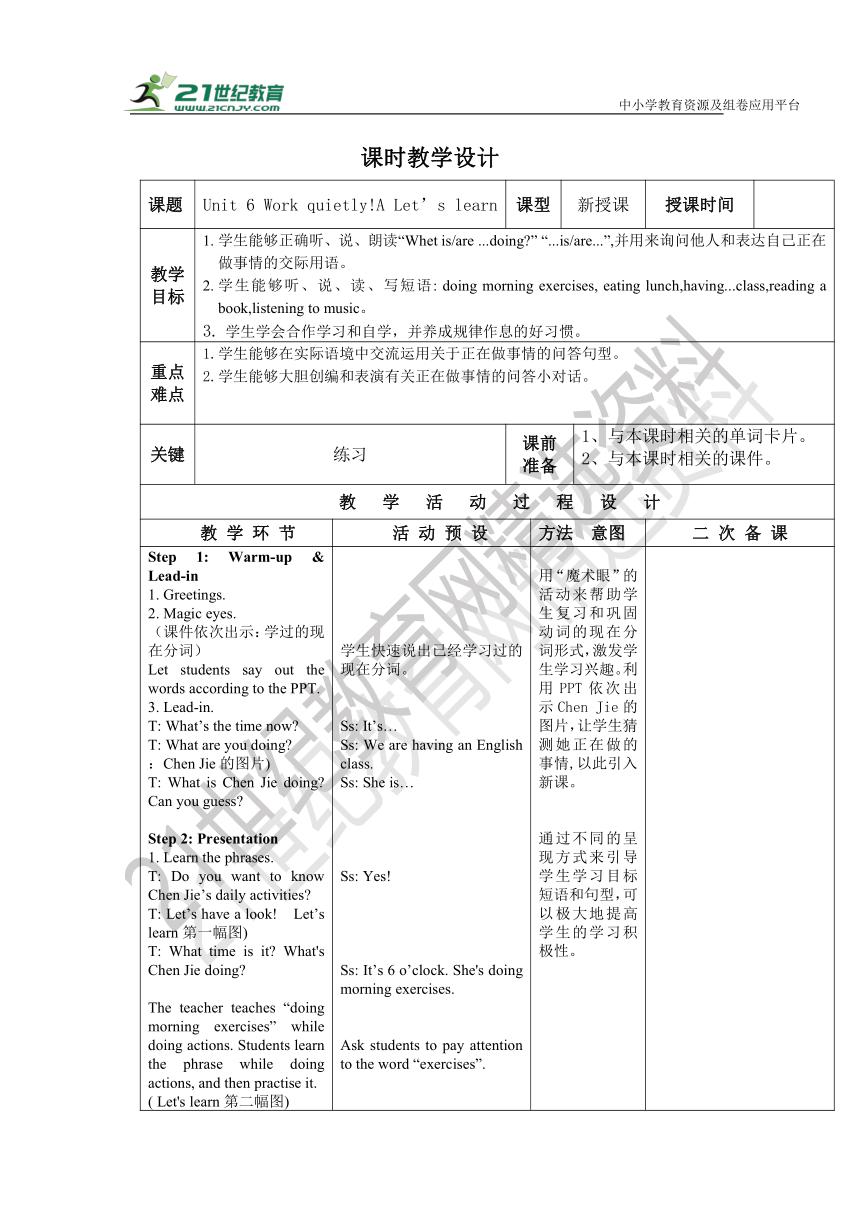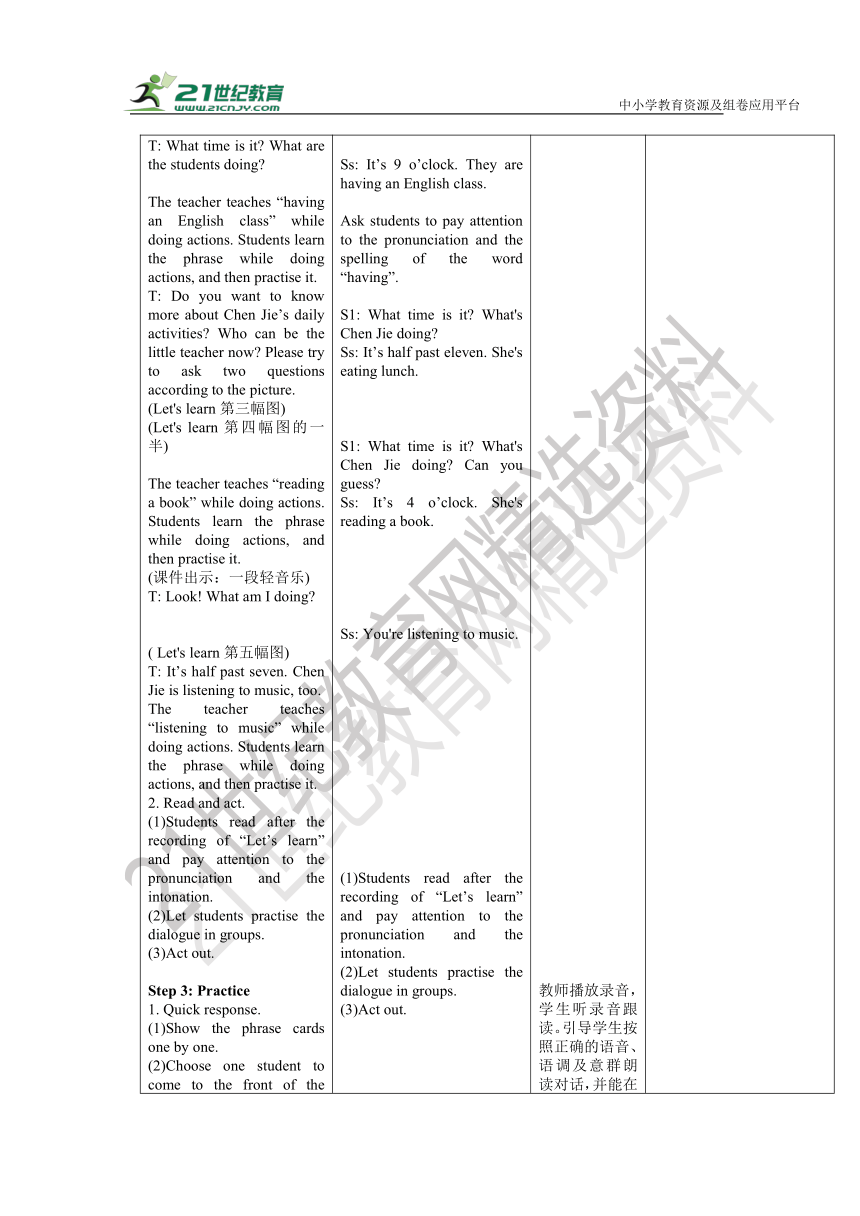【课堂跟踪】Unit 6 Work quietly! A Let’s learn 教案
文档属性
| 名称 | 【课堂跟踪】Unit 6 Work quietly! A Let’s learn 教案 |  | |
| 格式 | rar | ||
| 文件大小 | 215.0KB | ||
| 资源类型 | 试卷 | ||
| 版本资源 | 人教版(PEP) | ||
| 科目 | 英语 | ||
| 更新时间 | 2021-01-14 14:00:13 | ||
图片预览


文档简介
课时教学设计
课题
Unit 6 Work quietly!A Let’s learn
课型
新授课
授课时间
教学
目标
学生能够正确听、说、朗读“Whet is/are ...doing?” “...is/are...”,并用来询问他人和表达自己正在做事情的交际用语。
学生能够听、说、读、写短语: doing morning exercises, eating lunch,having...class,reading a book,listening to music。
学生学会合作学习和自学,并养成规律作息的好习惯。
重点难点
1.学生能够在实际语境中交流运用关于正在做事情的问答句型。
2.学生能够大胆创编和表演有关正在做事情的问答小对话。
关键
练习
课前
准备
与本课时相关的单词卡片。
与本课时相关的课件。
教 学 活 动 过 程 设 计
教 学 环 节
活 动 预 设
方法 意图
二 次 备 课
Step 1: Warm-up & Lead-in
1. Greetings.
2. Magic eyes.
(课件依次出示:学过的现在分词)
Let students say out the words according to the PPT.
3. Lead-in.
T: What’s the time now?
T: What are you doing?
:Chen Jie的图片)
T: What is Chen Jie doing? Can you guess?
Step 2: Presentation
1. Learn the phrases.
T: Do you want to know Chen Jie’s daily activities?
T: Let’s have a look! Les’s learn第一幅图)
T: What time is it? What's Chen Jie doing?
The teacher teaches “doing morning exercises” while doing actions. Students learn the phrase while doing actions, and then practise it.
( Let's learn第二幅图)
T: What time is it? What are the students doing?
The teacher teaches “having an English class” while doing actions. Students learn the phrase while doing actions, and then practise it.
T: Do you want to know more about Chen Jie’s daily activities? Who can be the little teacher now? Please try to ask two questions according to the picture.
(Let's learn第三幅图)
(Let's learn第四幅图的一半)
The teacher teaches “reading a book” while doing actions. Students learn the phrase while doing actions, and then practise it.
(课件出示:一段轻音乐)
T: Look! What am I doing?
( Let's learn第五幅图)
T: It’s half past seven. Chen Jie is listening to music, too.
The teacher teaches “listening to music” while doing actions. Students learn the phrase while doing actions, and then practise it.
2. Read and act.
(1)Students read after the recording of “Let’s learn” and pay attention to the pronunciation and the intonation.
(2)Let students practise the dialogue in groups.
(3)Act out.
Step 3: Practice
1. Quick response.
(1)Show the phrase cards one by one.
(2)Choose one student to come to the front of the classroom and do some actions according to the phrases on the cards. Let the other students say out the actions quickly.
2.Look and say.
( Look and say图片)
T: Look at the pictures. Try to talk about them with the sentence pattern “…is/are doing…”. Who can say quickly? Let’s have a competition.
Step 4: Consolidation & Extension
1. Make dialogues.
Show Jack’s daily activities. (男孩Jack的作息活动)
T: Look! This is Jack’s daily activities. Please make dialogues according to the pictures. You can say like this:
2.Show the dialogues.
学生快速说出已经学习过的现在分词。
Ss: It’s…
Ss: We are having an English class.
Ss: She is…
Ss: Yes!
Ss: It’s 6 o’clock. She's doing morning exercises.
Ask students to pay attention to the word “exercises”.
Ss: It’s 9 o’clock. They are having an English class.
Ask students to pay attention to the pronunciation and the spelling of the word “having”.
S1: What time is it? What's Chen Jie doing?
Ss: It’s half past eleven. She's eating lunch.
S1: What time is it? What's Chen Jie doing? Can you guess?
Ss: It’s 4 o’clock. She's reading a book.
Ss: You're listening to music.
(1)Students read after the recording of “Let’s learn” and pay attention to the pronunciation and the intonation.
(2)Let students practise the dialogue in groups.
(3)Act out.
Students read the phrases on the cards quickly. (“doing morning exercises; having an English class; eating lunch; reading a book; listening to music…”)
S1: Mike is listening to music.
S2: Zhang Peng is reading a book.
S3: Chen Jie and Sarah are eating lunch.
S4: Wu Yifan and Robin are running.
A: What is Jack doing at 6:30 in the morning?
B: He is getting up at 6:30 in the morning.
…
用“魔术眼”的活动来帮助学生复习和巩固动词的现在分词形式,激发学生学习兴趣。利用PPT依次出示Chen Jie的图片,让学生猜测她正在做的事情,以此引入新课。
通过不同的呈现方式来引导学生学习目标短语和句型,可以极大地提高学生的学习积极性。
教师播放录音,学生听录音跟读。引导学生按照正确的语音、语调及意群朗读对话,并能在小组中进行角色表演。
通过快速反应游戏来让学生操练现在分词短语。观察图片抢答游戏能够迅速使学生集中注意力,同时创造良好的学习氛围。
通过观察Jack的日常作息时间表并使用现在进行时来创编对话,让学生在情境中合理运用所学词汇和句型,培养学生的综合语言运用能力。
作业
设计
必做:
完成同步练习册相应习题,下节课检查。
将新词组每个抄写5遍并默写,背给同桌听。
选做:用今天的目标语句,创编一个六到八句的对话,作为下节课的Free talk。
板书
设计
-9525106680
教学反思
课题
Unit 6 Work quietly!A Let’s learn
课型
新授课
授课时间
教学
目标
学生能够正确听、说、朗读“Whet is/are ...doing?” “...is/are...”,并用来询问他人和表达自己正在做事情的交际用语。
学生能够听、说、读、写短语: doing morning exercises, eating lunch,having...class,reading a book,listening to music。
学生学会合作学习和自学,并养成规律作息的好习惯。
重点难点
1.学生能够在实际语境中交流运用关于正在做事情的问答句型。
2.学生能够大胆创编和表演有关正在做事情的问答小对话。
关键
练习
课前
准备
与本课时相关的单词卡片。
与本课时相关的课件。
教 学 活 动 过 程 设 计
教 学 环 节
活 动 预 设
方法 意图
二 次 备 课
Step 1: Warm-up & Lead-in
1. Greetings.
2. Magic eyes.
(课件依次出示:学过的现在分词)
Let students say out the words according to the PPT.
3. Lead-in.
T: What’s the time now?
T: What are you doing?
:Chen Jie的图片)
T: What is Chen Jie doing? Can you guess?
Step 2: Presentation
1. Learn the phrases.
T: Do you want to know Chen Jie’s daily activities?
T: Let’s have a look! Les’s learn第一幅图)
T: What time is it? What's Chen Jie doing?
The teacher teaches “doing morning exercises” while doing actions. Students learn the phrase while doing actions, and then practise it.
( Let's learn第二幅图)
T: What time is it? What are the students doing?
The teacher teaches “having an English class” while doing actions. Students learn the phrase while doing actions, and then practise it.
T: Do you want to know more about Chen Jie’s daily activities? Who can be the little teacher now? Please try to ask two questions according to the picture.
(Let's learn第三幅图)
(Let's learn第四幅图的一半)
The teacher teaches “reading a book” while doing actions. Students learn the phrase while doing actions, and then practise it.
(课件出示:一段轻音乐)
T: Look! What am I doing?
( Let's learn第五幅图)
T: It’s half past seven. Chen Jie is listening to music, too.
The teacher teaches “listening to music” while doing actions. Students learn the phrase while doing actions, and then practise it.
2. Read and act.
(1)Students read after the recording of “Let’s learn” and pay attention to the pronunciation and the intonation.
(2)Let students practise the dialogue in groups.
(3)Act out.
Step 3: Practice
1. Quick response.
(1)Show the phrase cards one by one.
(2)Choose one student to come to the front of the classroom and do some actions according to the phrases on the cards. Let the other students say out the actions quickly.
2.Look and say.
( Look and say图片)
T: Look at the pictures. Try to talk about them with the sentence pattern “…is/are doing…”. Who can say quickly? Let’s have a competition.
Step 4: Consolidation & Extension
1. Make dialogues.
Show Jack’s daily activities. (男孩Jack的作息活动)
T: Look! This is Jack’s daily activities. Please make dialogues according to the pictures. You can say like this:
2.Show the dialogues.
学生快速说出已经学习过的现在分词。
Ss: It’s…
Ss: We are having an English class.
Ss: She is…
Ss: Yes!
Ss: It’s 6 o’clock. She's doing morning exercises.
Ask students to pay attention to the word “exercises”.
Ss: It’s 9 o’clock. They are having an English class.
Ask students to pay attention to the pronunciation and the spelling of the word “having”.
S1: What time is it? What's Chen Jie doing?
Ss: It’s half past eleven. She's eating lunch.
S1: What time is it? What's Chen Jie doing? Can you guess?
Ss: It’s 4 o’clock. She's reading a book.
Ss: You're listening to music.
(1)Students read after the recording of “Let’s learn” and pay attention to the pronunciation and the intonation.
(2)Let students practise the dialogue in groups.
(3)Act out.
Students read the phrases on the cards quickly. (“doing morning exercises; having an English class; eating lunch; reading a book; listening to music…”)
S1: Mike is listening to music.
S2: Zhang Peng is reading a book.
S3: Chen Jie and Sarah are eating lunch.
S4: Wu Yifan and Robin are running.
A: What is Jack doing at 6:30 in the morning?
B: He is getting up at 6:30 in the morning.
…
用“魔术眼”的活动来帮助学生复习和巩固动词的现在分词形式,激发学生学习兴趣。利用PPT依次出示Chen Jie的图片,让学生猜测她正在做的事情,以此引入新课。
通过不同的呈现方式来引导学生学习目标短语和句型,可以极大地提高学生的学习积极性。
教师播放录音,学生听录音跟读。引导学生按照正确的语音、语调及意群朗读对话,并能在小组中进行角色表演。
通过快速反应游戏来让学生操练现在分词短语。观察图片抢答游戏能够迅速使学生集中注意力,同时创造良好的学习氛围。
通过观察Jack的日常作息时间表并使用现在进行时来创编对话,让学生在情境中合理运用所学词汇和句型,培养学生的综合语言运用能力。
作业
设计
必做:
完成同步练习册相应习题,下节课检查。
将新词组每个抄写5遍并默写,背给同桌听。
选做:用今天的目标语句,创编一个六到八句的对话,作为下节课的Free talk。
板书
设计
-9525106680
教学反思
